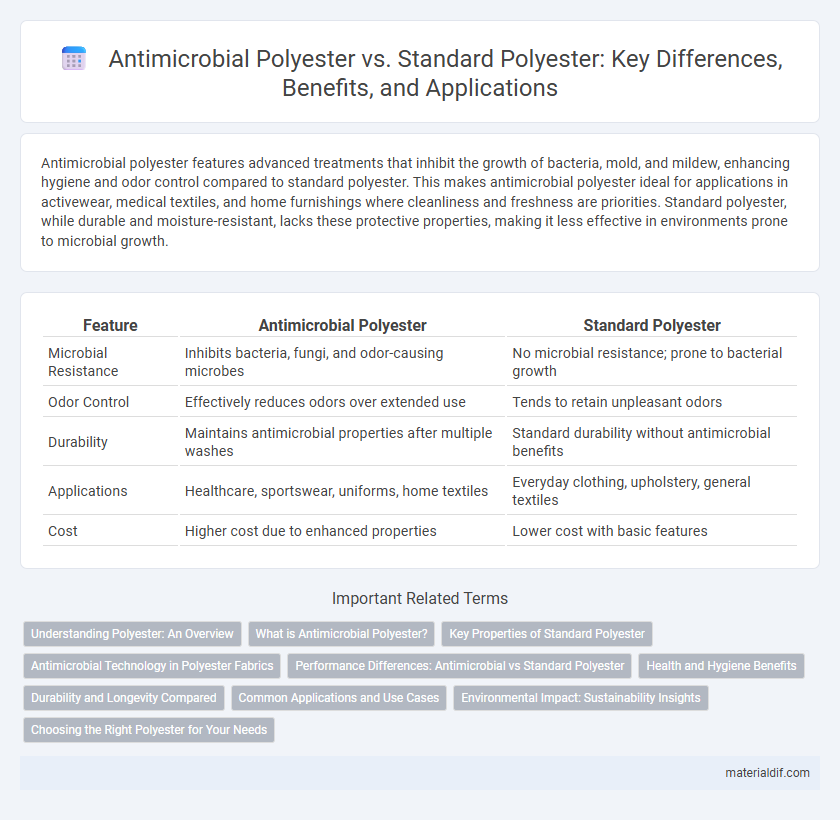Antimicrobial polyester features advanced treatments that inhibit the growth of bacteria, mold, and mildew, enhancing hygiene and odor control compared to standard polyester. This makes antimicrobial polyester ideal for applications in activewear, medical textiles, and home furnishings where cleanliness and freshness are priorities. Standard polyester, while durable and moisture-resistant, lacks these protective properties, making it less effective in environments prone to microbial growth.
Table of Comparison
| Feature | Antimicrobial Polyester | Standard Polyester |
|---|---|---|
| Microbial Resistance | Inhibits bacteria, fungi, and odor-causing microbes | No microbial resistance; prone to bacterial growth |
| Odor Control | Effectively reduces odors over extended use | Tends to retain unpleasant odors |
| Durability | Maintains antimicrobial properties after multiple washes | Standard durability without antimicrobial benefits |
| Applications | Healthcare, sportswear, uniforms, home textiles | Everyday clothing, upholstery, general textiles |
| Cost | Higher cost due to enhanced properties | Lower cost with basic features |
Understanding Polyester: An Overview
Polyester is a synthetic fiber derived from petroleum-based polymers, known for its durability, resistance to shrinking, and quick-drying properties. Antimicrobial polyester incorporates agents such as silver ions or copper compounds, which inhibit bacterial growth and reduce odors, enhancing hygiene and fabric longevity. Compared to standard polyester, antimicrobial variants offer improved performance in activewear, medical textiles, and environments requiring enhanced cleanliness.
What is Antimicrobial Polyester?
Antimicrobial polyester is a type of fabric treated with agents that inhibit the growth of bacteria, fungi, and odors, enhancing hygiene and freshness. Unlike standard polyester, which lacks these properties, antimicrobial polyester provides increased protection against microbial contamination, making it ideal for sportswear, medical textiles, and activewear. The integration of silver ions or other biocides in the polyester fibers ensures long-lasting antimicrobial effectiveness without compromising durability or comfort.
Key Properties of Standard Polyester
Standard polyester features high tensile strength, excellent wrinkle resistance, and moisture-wicking capabilities, making it ideal for durable and comfortable textiles. It offers good abrasion resistance and maintains colorfastness under various environmental conditions. While cost-effective and versatile, it lacks inherent antimicrobial properties, which can lead to odor retention and bacterial growth over time.
Antimicrobial Technology in Polyester Fabrics
Antimicrobial polyester incorporates advanced antimicrobial technology that inhibits the growth of bacteria, fungi, and other microbes on the fabric surface, enhancing hygiene and odor control. This technology often utilizes silver ions or other biocidal agents embedded in polyester fibers to provide long-lasting protection without compromising fabric durability or breathability. Compared to standard polyester, antimicrobial polyester significantly reduces microbial contamination, making it ideal for healthcare, sportswear, and activewear applications.
Performance Differences: Antimicrobial vs Standard Polyester
Antimicrobial polyester incorporates agents that inhibit the growth of bacteria, fungi, and odor-causing microorganisms, providing enhanced hygiene and extended freshness compared to standard polyester. Standard polyester, while durable and moisture-wicking, lacks inherent antimicrobial properties, which can lead to odor retention and potential microbial buildup over time. The performance difference is especially critical in activewear, healthcare textiles, and hospitality industries where sanitation and odor control are paramount.
Health and Hygiene Benefits
Antimicrobial polyester incorporates advanced agents that inhibit the growth of bacteria, fungi, and odors, significantly enhancing health and hygiene compared to standard polyester. This innovative fabric reduces the risk of infections and skin irritations, making it ideal for activewear, medical textiles, and everyday clothing. Its ability to maintain freshness and cleanliness promotes improved overall wellbeing and reduces the need for frequent washing.
Durability and Longevity Compared
Antimicrobial polyester incorporates additives that inhibit the growth of bacteria, fungi, and odors, enhancing fabric hygiene and lifespan compared to standard polyester. This treatment not only maintains the material's structural integrity but also reduces degradation caused by microbial activity, resulting in superior durability over time. Standard polyester, while strong and resistant to wear, lacks these protective qualities, which can lead to quicker deterioration and reduced longevity in environments prone to moisture and contamination.
Common Applications and Use Cases
Antimicrobial polyester is widely used in healthcare uniforms, sports apparel, and bedding to inhibit bacterial growth and reduce odors, enhancing hygiene and comfort. Standard polyester remains prevalent in everyday clothing, upholstery, and industrial textiles due to its durability and cost-effectiveness. Both types serve in outdoor gear and home textiles, but antimicrobial polyester offers added protection in environments requiring higher cleanliness standards.
Environmental Impact: Sustainability Insights
Antimicrobial polyester incorporates biocidal agents that reduce microbial growth, potentially extending garment lifespan and decreasing waste compared to standard polyester. However, the production of antimicrobial treatments often involves chemicals that may pose environmental risks during manufacturing and eventual textile disposal. Standard polyester, primarily derived from non-renewable petroleum, exhibits significant carbon emissions and microplastic pollution but lacks additional chemical treatments, making its environmental footprint more straightforward yet still impactful.
Choosing the Right Polyester for Your Needs
Antimicrobial polyester incorporates specialized treatments or coatings that inhibit bacterial growth, making it ideal for medical, athletic, and hygiene-sensitive applications. Standard polyester offers durability, moisture resistance, and affordability but lacks built-in antimicrobial properties. Selecting the right polyester depends on prioritizing factors like hygiene requirements, intended use environment, and budget constraints to ensure optimal performance and safety.
Antimicrobial Polyester vs Standard Polyester Infographic

 materialdif.com
materialdif.com